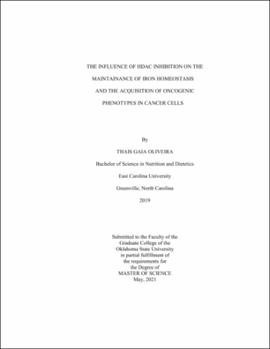| dc.contributor.advisor | Montgomery, Mckale | |
| dc.contributor.author | Oliveira, Thais Gaia | |
| dc.date.accessioned | 2023-03-16T16:56:47Z | |
| dc.date.available | 2023-03-16T16:56:47Z | |
| dc.date.issued | 2021-12 | |
| dc.identifier.uri | https://hdl.handle.net/11244/337109 | |
| dc.description.abstract | Epithelial-to-mesenchymal transition (EMT), an essential mechanism for development and wound healing, but in cancer it also mediates the progression and spread of aggressive tumors while increasing therapeutic resistance. The use of histone deacetylase (HDAC) inhibitors as therapy is FDA approved for so-called "liquid" cancers, however, treatment success in solid tumors is limited. Although HDAC inhibitors treatment decreases proliferation, it has also been shown to induce EMT in many types of cancer cells. Adoption of a mesenchymal state is also associated with increased iron uptake, but the relationship between EMT and the key regulators of cellular iron metabolism remains undefined. In this regard, the human adrenal cortical carcinoma SW13 cell line represents an invaluable research model as it can exist as two phenotypically distinct, epithelial- (SW13-) and mesenchymal-like (SW13+) subtypes. In this study we establish SW13 cells as a model for exploring the link between iron and EMT. We then go on to show that increased iron accumulation following HDAC inhibitor-mediated EMT is associated with decreased expression of the iron export protein ferroportin, enhanced ROS production, and reduced expression of antioxidant response genes. As availability of redox active iron and loss of lipid peroxide repair capacity are hallmarks of ferroptosis, a form of iron-mediated cell death, we next examined whether HDAC inhibitor treatment could augment ferroptosis sensitivity. Indeed, HDAC inhibitor treatment synergistically increased erastin-mediated ferroptotic cell death. As several HDAC inhibitors are already FDA-approved for the treatment of certain cancer types, the findings from these studies could have immediate implications for improving iron-targeted chemotherapeutic strategies. | |
| dc.format | application/pdf | |
| dc.language | en_US | |
| dc.rights | Copyright is held by the author who has granted the Oklahoma State University Library the non-exclusive right to share this material in its institutional repository. Contact Digital Library Services at lib-dls@okstate.edu or 405-744-9161 for the permission policy on the use, reproduction or distribution of this material. | |
| dc.title | Influence of HDAC inhibition on the maintanance of iron homeostasis and the acquisition of oncogenic phenotype in cancer cells | |
| dc.contributor.committeeMember | Lin, Daniel | |
| dc.contributor.committeeMember | Chowanadisai, Winyoo W | |
| osu.filename | Oliveira_okstate_0664M_17200.pdf | |
| osu.accesstype | Open Access | |
| dc.type.genre | Thesis | |
| dc.type.material | Text | |
| dc.subject.keywords | cancer | |
| dc.subject.keywords | EMY | |
| dc.subject.keywords | iron | |
| dc.subject.keywords | mesenchymal | |
| dc.subject.keywords | phenotype | |
| dc.subject.keywords | SW13 | |
| thesis.degree.discipline | Nutrition Science | |
| thesis.degree.grantor | Oklahoma State University | |
